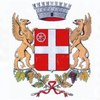Calosso
Calosso | |
|---|---|
| Comune di Calosso | |
 | |
| Coordinates: 44°44′N 8°14′E / 44.733°N 8.233°E | |
| Country | Italy |
| Region | Piedmont |
| Province | Province of Asti (AT) |
| Frazioni | frazione Castagna, frazione Piana del Salto, frazione Mosiano, regione Rodotiglia, regione San Bovo, regione Soria [1] |
| Government | |
| • Mayor | Migliardi Pier Francesco (elected 26 maggio 2019> (Vivere e Migliorare Insieme) |
| Area | |
| • Total | 15.7 km2 (6.1 sq mi) |
| Elevation | 235 m (771 ft) |
| Highest elevation | 399 m (1,309 ft) |
| Lowest elevation | 155 m (509 ft) |
| Population (Jan. 2024)[3] | |
| • Total | 1,112 |
| • Density | 71/km2 (180/sq mi) |
| Demonym | Calossesi |
| Time zone | UTC+1 (CET) |
| • Summer (DST) | UTC+2 (CEST) |
| Postal code | 14052 |
| Dialing code | 0141 |
| ISTAT code | 005015 |
| Patron saint | Beato Alessandro Sauli |
| Saint day | 11 October |
| Website | Official website |
Calosso is a rural comune (municipality) in the Province of Asti in the Italian region Piedmont, located about 60 kilometres (37 mi) southeast of Turin and about 20 kilometres (12 mi) south of Asti in the hilly area between the Tanaro and Belbo and on the borders between Monferrato and Langa. As of 31 January 2024, it had a population of 1,112 and an area of 15.7 square kilometres (6.1 sq mi).[4]
The comune borders the following municipalities: Agliano Terme, Canelli, Castiglione Tinella, Costigliole d'Asti, Moasca, and Santo Stefano Belbo.
The village itself, together with its castle, stands on a hill surrounded by the vineyards which represent its principal economic activity.
History[edit]
The first documented mention of Calosso dates back to 960, citing a certain Arimanno de Calocio as a witness to a land exchange. In the 12th century, Calosso became part of the consortile of Acquosana with the lords of other minor fiefs in the area. In 1318, the town was involved in the civil war between the Solaro Guelphs and the De Castello Ghibellines. The Guelphs destroyed the castle of Calosso, which was later reconstructed. In 1377, the entire fiefdom passed to the Asti noble banker Percivalle Roero, who later gave control to Valentina Visconti, who married Louis of Orléans in 1387. The county of Asti thus became a French possession. In 1531, Calosso passed to the House of Savoy and was constantly occupied by various armies during the War of the Monferrato Succession. With the Peace of the Pyrenees in 1659, Calosso lost its strategic importance, and the castle became the country residence of the Roero family.
Local government[edit]
The comune belongs to the Comunità delle colline tra Langa e Monferrato.
Viticulture[edit]
Around two thirds of the area of the commune, and by far the greatest part of its agricultural land is devoted to vineyards. Production is on a small scale: this 10 square kilometres (4 sq mi) or so is divided between 380 farms and the total annual production of wine is around 4,900,000 litres (1,300,000 US gal).
The principal grape variety grown here is the Moscato Bianco, while others include Barbera, Dolcetto, Nebbiolo, Chardonnay and Freisa. Of particular interest is the cultivation of the now rare historical variety Gamba di Pernice (literally ‘Pheasant’s leg’).[5]
Demographic evolution[edit]

References[edit]
- ^ Comune di Calosso (AT) - Italia: Informazioni
- ^ "Superficie di Comuni Province e Regioni italiane al 9 ottobre 2011". Italian National Institute of Statistics. Retrieved 16 March 2019.
- ^ "Popolazione Residente al 1° Gennaio 2018". Italian National Institute of Statistics. Retrieved 16 March 2019.
- ^ All demographics and other statistics: Italian statistical institute Istat.
- ^ "Comune di Calloso :: Vignetti". Archived from the original on 2006-05-06. Retrieved 2006-09-21.




